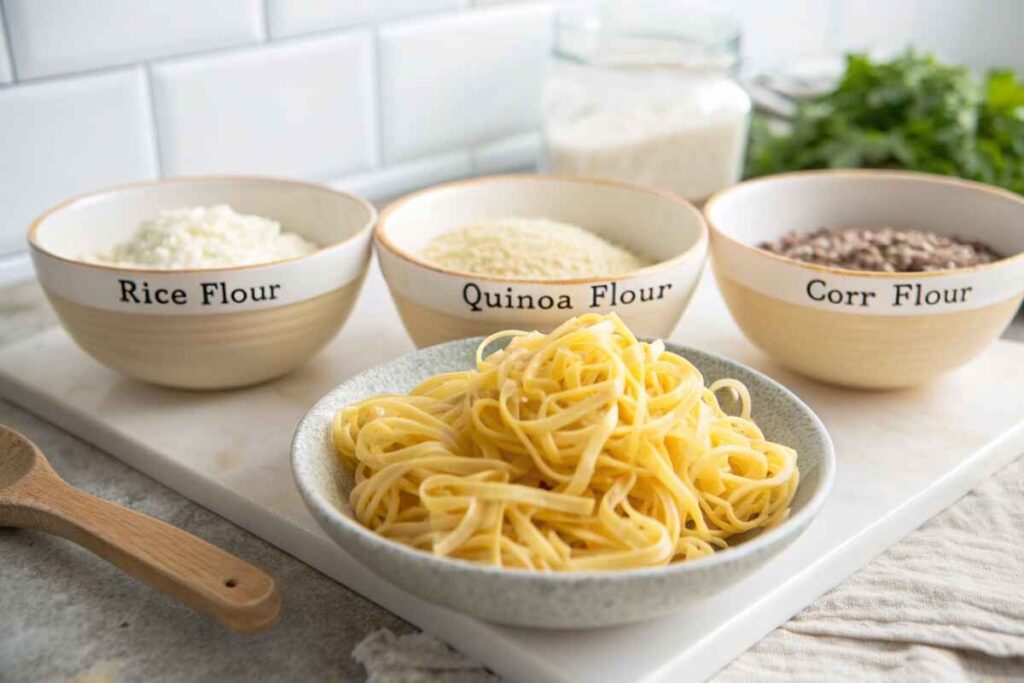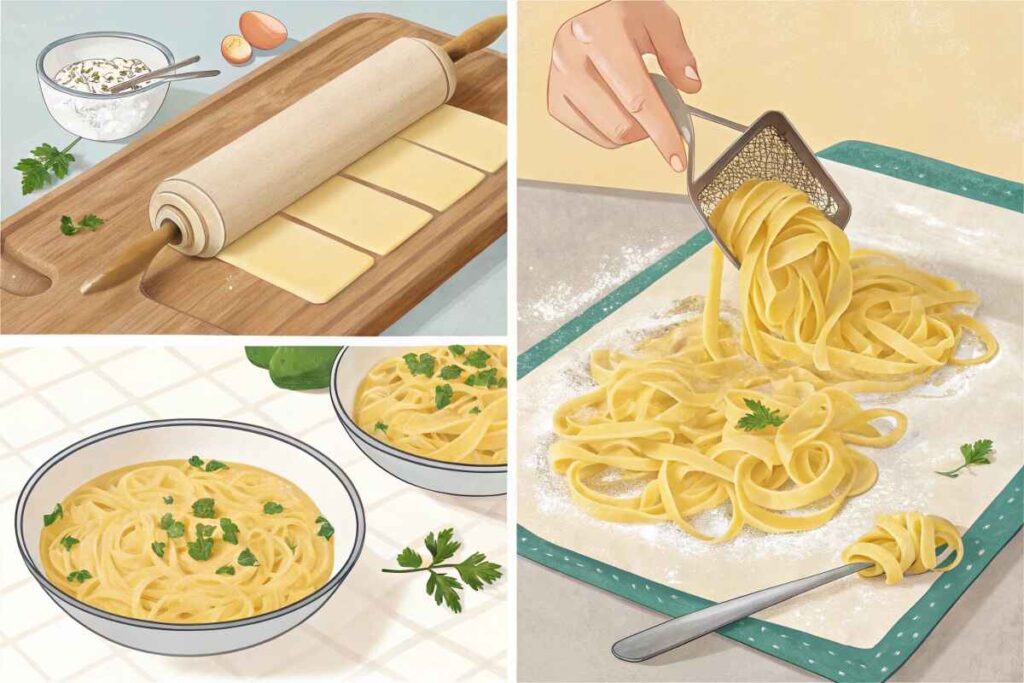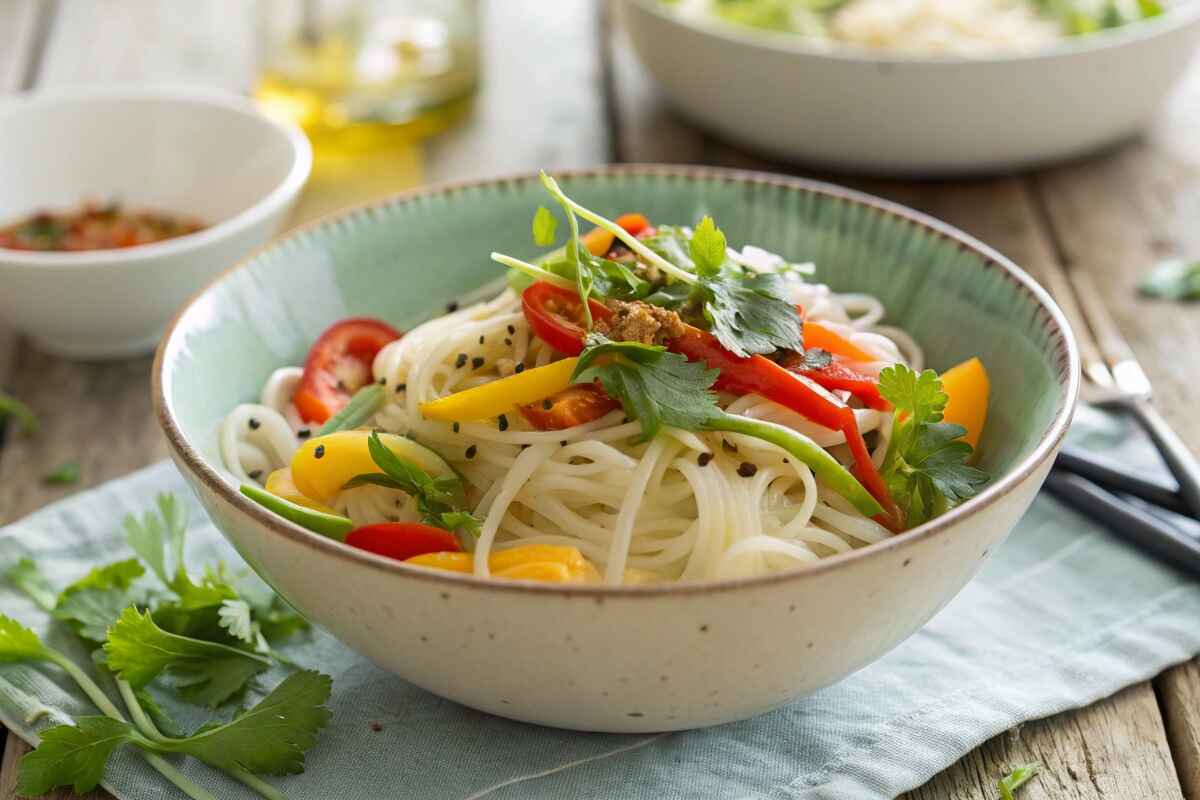Gluten-free egg noodles have carved out a niche in the culinary world, offering a delightful alternative to those with gluten sensitivities or celiac disease. Whether you’re craving a warm bowl of soup or a satisfying stir-fry, these noodles bring versatility and flavor to the table without compromising dietary restrictions. This guide dives deep into the world of gluten-free egg noodles, exploring their ingredients, benefits, recipes, and the best brands available.
Table of contents
Introduction to Gluten-Free Egg Noodles
What Are Gluten-Free Egg Noodles?
Gluten-free egg noodles offer a specially crafted pasta alternative for individuals who avoid gluten, a protein found in wheat, barley, and rye. Instead of using wheat flour like traditional egg noodles, they rely on alternative flours such as rice, quinoa, or corn to achieve a similar texture and taste.
These noodles preserve the classic egg noodle shape and flavor while eliminating gluten, making them a perfect choice for anyone with dietary restrictions or health-conscious goals. Even without gluten, they deliver versatility and easily fit into a variety of dishes.
Why Choose Gluten-Free Egg Noodles?
There are several reasons people opt for gluten-free egg noodles beyond just dietary needs. For starters, they’re an excellent option for those looking to cut down on gluten while still enjoying comforting and familiar meals. Gluten-free options also tend to be easier on digestion for people with gluten intolerance or irritable bowel syndrome (IBS).
Additionally, gluten-free egg noodles often use nutrient-rich flours like brown rice flour or quinoa flour, adding a healthy twist to traditional pasta dishes. Their slightly softer texture can also be a welcome change for those seeking a gentler chew in their noodles.
In summary, gluten-free egg noodles are a perfect blend of taste, nutrition, and dietary flexibility, making them a staple in many households today.
Ingredients and Manufacturing Process
Common Ingredients in Gluten-Free Egg Noodles
The hallmark of gluten-free egg noodles lies in their ingredients, which carefully replace traditional wheat flour with alternative flours. These substitutes are chosen not only for their gluten-free properties but also for their ability to mimic the texture and flavor of classic egg noodles. Some popular ingredients include:
- Rice Flour: A staple in gluten-free cooking, rice flour is light and neutral, creating smooth, mild-tasting noodles.
- Corn Flour: This flour adds a slightly sweet taste and works well in combination with other flours.
- Quinoa Flour: Known for its nutty flavor and high protein content, quinoa flour enhances both nutrition and taste.
- Tapioca Starch: Often used for elasticity, tapioca starch ensures the noodles maintain a chewy yet tender texture.
Many manufacturers also include xanthan gum or guar gum to bind the ingredients and provide elasticity, making the noodles resemble their wheat-based counterparts.
How Gluten-Free Egg Noodles Are Made
Making gluten-free egg noodles starts by mixing gluten-free flours and starches. Eggs or egg substitutes, water, and sometimes oil are added to make a dough. Here’s a simple breakdown:
- Mixing and Kneading: The ingredients are mixed into a consistent dough, which is kneaded to ensure elasticity.
- Rolling and Cutting: The dough is rolled out into thin sheets and cut into the signature noodle shapes, such as wide strips or thin strands.
- Drying: To increase shelf life, the noodles are dried at a controlled temperature, maintaining their structure.
- Packaging: Finally, the noodles are sealed in air-tight packages to preserve freshness and quality.
This meticulous process ensures that the gluten-free egg noodles offer a delightful bite and flavor, making them suitable for a wide range of dishes.
Benefits of Gluten-Free Egg Noodles

Health Benefits of Going Gluten-Free
Switching to gluten-free egg noodles can bring many health benefits, especially for people with gluten sensitivity or celiac disease. These noodles don’t contain gluten, a protein that can cause inflammation and stomach discomfort in sensitive people. They are often made with healthy flours like brown rice or quinoa, which add important vitamins and minerals to your meals.
For those looking to manage their weight, gluten-free egg noodles can be part of a balanced diet when paired with lean meats and vegetables. Their lighter nature may also appeal to anyone who wants to improve digestion and reduce bloating.
Nutritional Comparison: Gluten-Free vs. Traditional Egg Noodles
Gluten-free egg noodles often provide fewer carbohydrates than their traditional counterparts, depending on the flour used. Flours like quinoa and chickpea are rich in protein and fiber, making them a healthier alternative. While traditional egg noodles might edge out in terms of texture, gluten-free options offer a comparable experience with added health perks.
For instance:
- Gluten-free noodles made from quinoa flour contain more iron and magnesium, vital for energy and muscle function.
- Rice flour-based noodles are easier on sensitive stomachs, reducing gastrointestinal distress.
Switching to gluten-free egg noodles is not just about avoiding gluten; it’s about embracing a lifestyle that prioritizes better nutrition and health.
Buying Guide for Gluten-Free Egg Noodles

What to Look For When Buying
Choosing the right gluten-free egg noodles can be tricky with so many options available. Here are some key tips to keep in mind:
- Certified Gluten-Free Label: Always check for a certified gluten-free stamp on the packaging to ensure the noodles are safe for individuals with gluten sensitivity or celiac disease.
- Ingredient List: Opt for noodles made from high-quality, natural flours like rice, quinoa, or chickpeas. Avoid brands that include artificial additives or excessive preservatives.
- Texture and Cooking Time: Different flours create varied textures. Rice-based noodles tend to be smooth, while quinoa or corn flour may have a firmer bite. Adjust your choice based on your preference.
- Nutritional Value: Compare brands for added benefits like high protein, fiber content, or low sodium levels to fit your dietary needs.
By paying attention to these details, you’ll find gluten-free egg noodles that meet your taste and health requirements.
Best Stores and Online Retailers
Finding the perfect gluten-free egg noodles is easier when you know where to look. Local grocery stores often stock popular brands, but specialty health food stores are more likely to carry a wider variety.
For even more convenience, online platforms like Amazon, Thrive Market, and iHerb offer an extensive selection of gluten-free noodles, including brands like Jovial and Manischewitz. Additionally, websites like CooFoodKing provide curated food guides, which might help you discover new and unique gluten-free options.
Frequently Asked Questions
Are Any Egg Noodles Gluten-Free?
Yes, many egg noodles are now available in gluten-free varieties. Brands replace traditional wheat flour with alternatives like rice or corn flour to create safe options for those avoiding gluten. Always double-check labels to confirm the absence of gluten.
Is Gluten-Free Egg Noodle Free of All Allergens?
Not always. While they are free of gluten, some gluten-free egg noodles may contain eggs, soy, or traces of nuts, depending on the production facility. If you have multiple food allergies, look for brands that specifically state they are free of common allergens.
Where to Buy Gluten-Free Egg Noodles Near Me?
You can find gluten-free egg noodles at major grocery stores like Whole Foods, Sprouts, or Kroger. Health food stores and online marketplaces like Amazon also carry a wide variety, often with customer reviews to help you choose.
What Makes Gluten-Free Egg Noodles Unique?
Unlike traditional egg noodles, gluten-free versions use alternative flours that bring different textures and flavors. They cater to dietary needs while offering versatility in various recipes, from soups to stir-fries.
Conclusion
Embracing Gluten-Free Egg Noodles in Your Diet
Switching to gluten-free egg noodles opens up many food options without hurting your health or diet. These noodles are not just a safe choice for people with gluten issues—they’re a flexible and tasty addition to any meal. Whether made from rice, corn, or quinoa flour, they fit a variety of tastes and needs.
By learning about their benefits, ingredients, and how to buy and use them, you can make better choices. From enjoying warm noodle soups to cooking creative stir-fries, gluten-free egg noodles show that diet restrictions don’t mean giving up flavor.
Adding them to your pantry is more than a choice—it’s a step toward healthier and more inclusive eating. Start with your favorite recipes or try a new brand. After all, food should always bring happiness, no matter your diet!
Switching to gluten-free egg noodles doesn’t mean sacrificing flavor, texture, or variety. With so many high-quality brands and easy-to-follow recipes, it’s easier than ever to enjoy your favorite meals while adhering to a gluten-free lifestyle. Whether you’re whipping up a comforting bowl of chicken noodle soup or experimenting with a stir-fry, these noodles fit seamlessly into your culinary adventures.
For more information on gluten-free living and recipes, consider exploring these helpful resources:
- Celiac Disease Foundation – Comprehensive insights into celiac disease and gluten-free diets.
- Gluten-Free Society – Tips, recipes, and guides for gluten-free living.
- Gluten-Free on a Shoestring – Budget-friendly gluten-free recipes.
These links can deepen your understanding and inspire more creative dishes. Happy cooking! 😊
